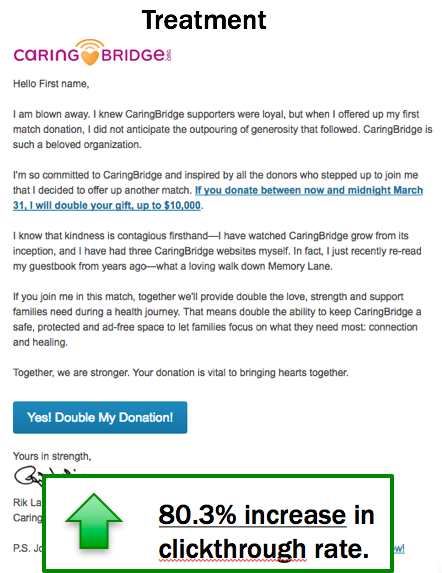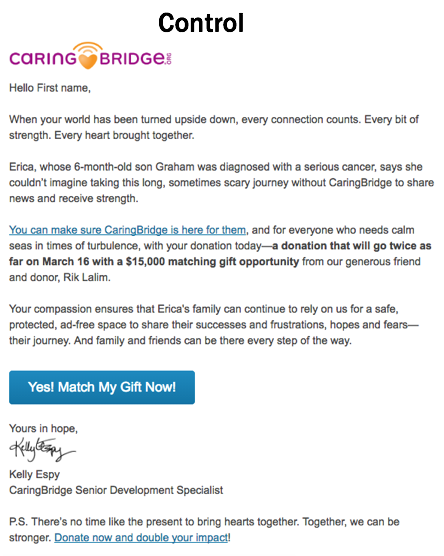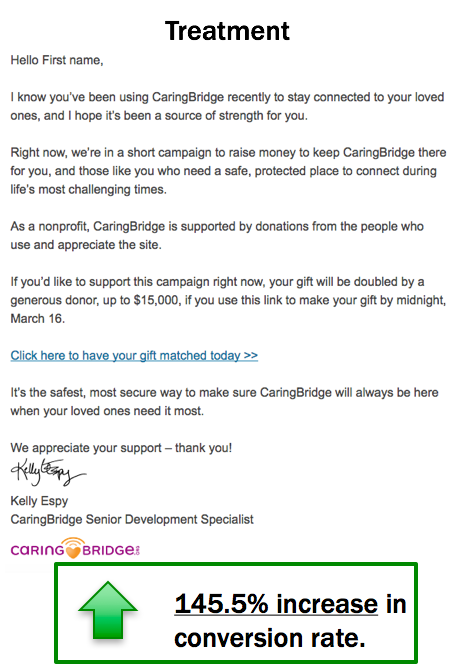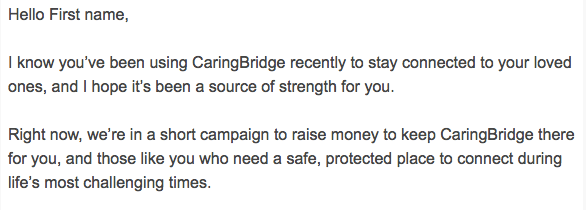For almost all of our clients and most nonprofits for that matter, email is the most valuable source for online donations so we’ve been kind of obsessed with figuring out how to send great emails (once you’ve acquired them, more on that here).
If I had to sum up our findings from experiments and experiences as to what makes a great email it would be this:
People give to people. Not email machines.
We actually have a poster of that hanging on our walls (for real) as it’s such a great summary of what we’ve learned and a reminder when it comes to creating successful emails.
Focusing a lot on email this past while and this poster in the @NextAfter_ office is a pretty good summary (and reminder) of what makes for great email fundraising: People give to people. Not email machines. pic.twitter.com/wfc7rxfbMs
— Brady Josephson (@bradyjosephson) March 20, 2018
Here’s an example of that when it comes to design. Here was their usual email:

Pretty standard email with the logo, image header, copy making the case, big call-to-action button, personal signoff, and a PS. You may have noticed a pre-header at the top of the email as well. This isn’t a bad email and in many ways, a pretty good one but the intent of this email is pretty clear and quite early. It’s a marketing email.
So we wondered what would happen if we took out the branding and even the template itself to create a more personal feel using the same copy and call-to-action button to make it feel less templated and designed and here was the result:

The stripped-down email increased clicks to the donation page by 80.3% and because of that led to more donations.
A few key insights here:
- “Best practices” aren’t always best practices and need to be challenged and tested
- Your designed emails may be good but they may also be hindering your ability to raise funds
That designed email is basically what I was told was best and have created, sent, and recommended that style many times. A best practice.
And while the template is a good one and can show authority, it also communicates that this is a mass marketing email and might actually be hurting your fundraising. And if your inbox is like mine, you get a bunch of those and don’t need, or want, anymore.
Test your best practices and if you’re looking for a place to start, try getting rid of your email template on your next fundraising email and see how it goes.
So we found a ‘winning’ email here but good is the enemy of great and everything can be optimized and improved so, in another experiment with the same client, we wanted to see if we could go even further with the personalization.
Here was that new ‘winning’ email from the previous test:

This time for the experiment, we wanted to get even simpler and clearer with the ask. We created a new appeal and changed the copy to create a more personal tone. We wanted it to sound like a real person so we added relevance to the ask and we moved all the branding down to the signature block and took away the big button and replaced it with a hyperlink.
I don’t know about you and your friends, but I don’t get many big buttons in my emails from friends nor do I send emails with them. So that’s what we tried to replicate here:

In this case, the more personalized email increased donations 145.5%! It’s partly the simpler design here but take a look at the first few sentences of each email a bit closer:


Again, the first email isn’t bad. It starts out fine enough, tries to develop some connection, and gets into a story. Another ‘best practice’.
But in the treatment, we used ‘I’ and ‘you’ language to be more like a human sending an email to another human and create a sense of empathy before jumping into the campaign even without the story ‘hook’.
A few insights from this experiment:
- The tone can be one of the most impactful elements in email – more so than design, image placement, or sender lines
- People need to believe that the personal email is from a real person
If you’re looking for another area to test and improve your fundraising emails, look at your tone and voice. How can you make it more personal? How can you be more like a human and less like a marketing machine?
So…
Those are just two of the 218 experiments we looked at to see how you can optimize each of the 10 main elements of a fundraising email appeal to send better emails and raise more money. Being more human and personal was a common finding and the more you can infuse personalization into your emails the better chance you have to connect with your donors and move them towards a donation. Good luck!
 Brady Josephson
Brady Josephson
Vice President of Innovation and Optimization
NextAfter
Brady is a charity nerd, entrepreneur, digital marketer, professor, and writer. He’s the Vice President of Innovation and Optimization at NextAfter — a fundraising research lab and consultancy on a mission to unleash the most generous generation in the history of the world.
Brady works with nonprofits, thought leaders, and philanthropic partners to develop research and create content that can help organizations reach more people, acquire more donors, and generate more dollars to fund their world-changing work.
He’s spent his entire career in the nonprofit world working for nonprofits, in technology, and as a consultant. He’s an international speaker whose work and writing have been featured in The Huffington Post, Christianity Today, NPR, and The Chronicle of Philanthropy.
Brady lives just outside Vancouver, British Columbia, Canada with his wife Liz, dog Melly, and cat Thor. You can follow him on Twitter @bradyjosephson.




